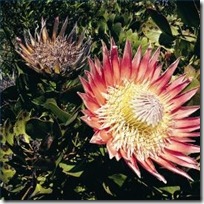The genus Protea contains a variety of species. Protea species vary widely in their flower shape, size and color, so many gardeners find this genus a joy to explore. However, only a small percentage of gardeners in North America can enjoy growing these beauties. Protea are native to South Africa and Australia and are ideally suited for growth in U.S. Department of Agriculture zones 8 and 9. For those living in cooler or hotter climates, protea may not be an ideal choice. Because of their excessively long taproot, protea are not suited for container growth.
Difficulty: Easy
Instructions
Things You’ll Need:
- Pebble bark mulch
- Palm fronds or newspaper
- Wire cage
- Drip irrigation system
- Pruning shears
-
Maintain a 1-inch layer of pebble bark over your protea bed (kept 1 inch from the plants’ main stem) for the plants’ first two years of growth in the site. This mulch deters weed growth, cools the plants’ shallow roots and helps the soil retain moisture.
-
Provide young or freshly transplanted protea with shade during their first year of growth at a site. Protea tolerate temperatures as high as 100 degrees Fahrenheit for 24 hours, but excessively high temperature negatively affects them. The cooler the temperature, the brighter the protea flowers will be. When the temperature climbs into the 90s and higher, erect a temporary shade (palm fronds or newspaper pages laid over a wire cage work nicely) over plants until the temperature drops.
-
Give your protea 1 inch of water weekly (if not provided by rain) only during their first two years of growth. Make sure that your water has a pH between acidic and neutral, no salt and low mineral content (hard water is toxic to protea). Water the base of the plants such as through drip irrigation–never water from overhead, which can lead to disease development. After their first two years of growth, protea only need supplemental watering in times of drought and high temperatures.
-
Prune away spent protea flower heads (if you have not already used them as cut flowers) to prevent the protea to putting energy into producing unwanted seeds.
-
Prune some protea stems back in early spring if the plant begins to look untidy. But never trim a stem that has no green leaves. It will not grow back.
Tips & Warnings
-
Protea are happiest when temperatures are between 40 and 90 degrees Fahrenheit. Temperatures higher than 100 degrees Fahrenheit may result in bud burn and reduced flowering. Temperatures below 25 degrees Fahrenheit can result in leaf burn and even death.
-
Protea in the home garden need no supplemental fertilization.
-
Protea grow best with southwestern or southeastern exposure except in the hottest inland climates, where they grow better with northern exposure.
-
Protea must have well-drained, low-nutrient soil to thrive. Sand and glass soils are ideal. Sandy loam suffices, but clay and silt soils are unsuitable for protea growth.
-
If your water table is lower than 40 feet, your protea will need more regular watering with drip irrigation.
-
Protea have shallow roots. Do not disturb them with tilling, weed pulling or hoeing. Rather, to reduce weeds, cut them off repeatedly at their base so that they stop growing.


1 thought on “How to Care for Protea”
Deprecated: strpos(): Passing null to parameter #1 ($haystack) of type string is deprecated in /home/agriviek8Qv/agriviet.net/public_html/wp-includes/comment-template.php on line 2522